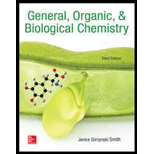
Concept explainers
(a)
Interpretation:
The boiling point of the solution formed upon the addition of
Concept introduction:
The effect of the addition of a non-volatile component to a solvent is that there is an increase in the boiling point. This is called elevation in boiling point. Such an increase is observed since the surface of the solvent is saturated with solute particles. This results in the lesser escape of gaseous molecules and hence the vapor pressure of the solution gets lowered compared to the vapor pressure found above the pure solvent to which no solute has been added.
The temperature at which the vapor pressure of solution becomes equal to the atmospheric pressure is known as the boiling point. Due to the lesser vapor pressure, the solution needs to be heated to higher temperatures in order to boil it. Therefore, the boiling point of the solution is elevated.
One mole of the nonvolatile solute increases the boiling point of one kilogram of water by
The extent of elevation in boiling point is directly proportional to the amount of non-volatile solute added. For example,
The formula to calculate the number of moles from the mass is given as follows:
The formula to calculate the molality is as follows:
The formula to calculate the elevation in boiling point is as follows:
The formula to calculate the molarity is as follows:
The formula to calculate
Want to see the full answer?
Check out a sample textbook solution
Chapter 8 Solutions
General, Organic, & Biological Chemistry
- What would be the freezing point of a solution formed by adding 1.0 mole of glucose (a molecular compound) to the following amounts of water? a. 250 g (0.25 kg) b. 500 g (0.500 kg) c. 1000 g (1.000 kg) d. 2000 g (2.000 kg)arrow_forwardHow many grams of lactose must be added to 655 g of water in order to prepare each of the following percent-by-mass concentrations of aqueous lactose solution? a. 0.50% b. 2.00% c. 10.0% d. 25.0%arrow_forwardAssume that 30 L of maple sap yields one kilogram of maple syrup (66% sucrose, C12H22O11). What is the molality of the sucrose solution after one fourth of the water content of the sap has been removed?arrow_forward
- A CaCl2 solution at 25C has an osmotic pressure of 16 atm and a density of 1.108 g/mL. What is the freezing point of this solution?arrow_forwardCalculate the molality of a solution made by dissolving 115.0 g ethylene glycol, HOCH2CH2OH, in 500. mL water. The density of water at this temperature is 0.978 g/mL. Calculate the molarity of the solution.arrow_forwardVinegar is a 5.0% solution of acetic acid (CH3CO2H) in water. The density of vinegar is 1.0055 g/mL. Express the concentration of acetic acid as (a) molality. (b) molarity. (c) mole fraction.arrow_forward
 General, Organic, and Biological ChemistryChemistryISBN:9781285853918Author:H. Stephen StokerPublisher:Cengage LearningChemistry: Matter and ChangeChemistryISBN:9780078746376Author:Dinah Zike, Laurel Dingrando, Nicholas Hainen, Cheryl WistromPublisher:Glencoe/McGraw-Hill School Pub Co
General, Organic, and Biological ChemistryChemistryISBN:9781285853918Author:H. Stephen StokerPublisher:Cengage LearningChemistry: Matter and ChangeChemistryISBN:9780078746376Author:Dinah Zike, Laurel Dingrando, Nicholas Hainen, Cheryl WistromPublisher:Glencoe/McGraw-Hill School Pub Co Chemistry: The Molecular ScienceChemistryISBN:9781285199047Author:John W. Moore, Conrad L. StanitskiPublisher:Cengage Learning
Chemistry: The Molecular ScienceChemistryISBN:9781285199047Author:John W. Moore, Conrad L. StanitskiPublisher:Cengage Learning Chemistry & Chemical ReactivityChemistryISBN:9781133949640Author:John C. Kotz, Paul M. Treichel, John Townsend, David TreichelPublisher:Cengage Learning
Chemistry & Chemical ReactivityChemistryISBN:9781133949640Author:John C. Kotz, Paul M. Treichel, John Townsend, David TreichelPublisher:Cengage Learning Chemistry & Chemical ReactivityChemistryISBN:9781337399074Author:John C. Kotz, Paul M. Treichel, John Townsend, David TreichelPublisher:Cengage Learning
Chemistry & Chemical ReactivityChemistryISBN:9781337399074Author:John C. Kotz, Paul M. Treichel, John Townsend, David TreichelPublisher:Cengage Learning Chemistry: Principles and PracticeChemistryISBN:9780534420123Author:Daniel L. Reger, Scott R. Goode, David W. Ball, Edward MercerPublisher:Cengage Learning
Chemistry: Principles and PracticeChemistryISBN:9780534420123Author:Daniel L. Reger, Scott R. Goode, David W. Ball, Edward MercerPublisher:Cengage Learning





